Designing
an Herb Garden.
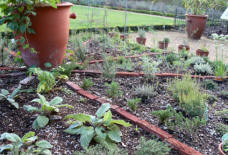 Most herb garden designs are laid out in geometric shapes. If you prefer a
formal look, you may want to edge your garden beds with boxwoods.
For a country look, you could plant your herbs in an old wagon
wheel, instead. Most herb garden designs are laid out in geometric shapes. If you prefer a
formal look, you may want to edge your garden beds with boxwoods.
For a country look, you could plant your herbs in an old wagon
wheel, instead.
Selecting the plants for your basic herb
garden.
If you plan to use a favorite herb heavily, you should
purchase three to five plants. If you are just buying a plant
because you like the way it looks or smells, you may only want to
buy one to three plants.
One of the most important tips to remember when planting an
herb garden is to plant your
herbs in groups of three, five, seven or more. For some reason, odd
numbered groups of plants seem to look the best.
Of course, knowing how many plants to use in each grouping doesnít
help you design a herb garden if you arenít sure where to place the
plants. Take a look at nature. Plants donít grow in tidy rows.
Instead, they grow in a curve, with some plants jutting forward and
others hanging back.
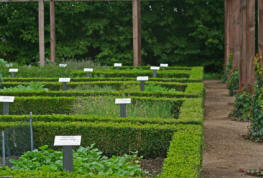
You probably donít want your herb garden to appear unorganized. Easy
fix - take a look at each herb plant's growth habit. Most tall herbs
should be in the back of the herb bed, while low growers should be
in the front. Occasionally, you might place a taller plant in the
front of the bed for a bit of variety.
Purchasing your Herb plants
This is probably the most enjoyable thing to do as you design a herb
garden. If possible, go to a plant nursery and actually touch and
smell the different herbs and herb gardening products. Place herbs beside each other to see how
they look together before you take them home.
After you know what the different herbs look and smell like, decide which ones you want to plant in your garden. Keep in mind as
you design your herb garden that you want to make it functional as
well as fun.
If you enjoy cooking with fresh herbs, you may want to use
plenty of culinary herbs in the design. If you want to grow a
basic herb garden for the kitchen, consider parsley, chives,
rosemary, fennel, and sage.
For all year round cooking, dry and save in well marked
containers. Your family and friends will be envious of your
home grown herbs and spices.
Herbs will keep best in bottles of darkly colored glass, but
if they are stored in a dark place, you can use any colored
bottle you have on hand. |
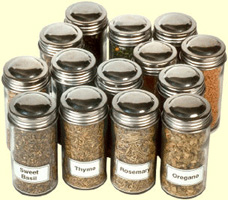 |
For people who rarely heat up the
stove, herbs that have healing properties may be a better choice.
For a healing garden, try coneflowers, pot marigolds, aloe vera and
feverfew.
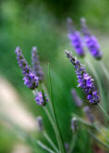 If you love scents, herbs used to make essential oils are ideal. For
an aromatherapy garden, lavender, lemon grass, and rosemary are
popular choices. If you love scents, herbs used to make essential oils are ideal. For
an aromatherapy garden, lavender, lemon grass, and rosemary are
popular choices.
Of course, if you like all of these things, you can always mix them
up in your Herb Garden.
Planting an Herb Garden.
Once you have all of the plants for your basic herb
garden, you will want to be sure they are planted properly. Pull
each plant out of the pot and check to be sure it is not pot bound.
When a plant is pot bound, the roots start to grow up around the
sides of the plantís root ball. Spread the roots at the bottom of
the root ball out to keep them from continuing to grow in a circle.
Dig a hole and place the plant in it so it's growing at the same
level as it was before. When all of your herbs are planted, water
them to remove any air pockets.
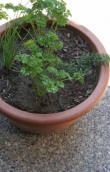 Outdoor herb gardens provide a wonderful opportunity to plant a wide
variety of herbs. But if you can't find a suitable location outside,
you can still have your fresh and organically grown herbs by
creating a patio herb garden or an indoor herb garden. Outdoor herb gardens provide a wonderful opportunity to plant a wide
variety of herbs. But if you can't find a suitable location outside,
you can still have your fresh and organically grown herbs by
creating a patio herb garden or an indoor herb garden.
Container and
windowsill herb gardens work quite well and there are many herb
garden kits to help you get started.
You have now designed and planted your first herb garden that will
bring you much pleasure and a full sense of accomplishment. Enjoy!
 >>
MORE HERB GARDEN TIPS
>>
MORE HERB GARDEN TIPS
RESOURCES:
1.
At Sage Hill Farms,
organic herbs grown by safe and natural methods of
farming produce healthier and better tasting products and give the
satisfaction of giving something back to Mother Earth. From
acres of land to a small patio container garden, there is something
each of us can do to improve the earth around us.
Subscribe to FREE Newsletter
and receive herb gardening tips from the
dedicated Sage Hill Farm family.
Visit the Sage Hill Farms web site and read "Bea's
Beatitudes on Herbs" blog.
Bea Kunz's monthly posts are warm and informative with herb
growing advice, great recipes and helpful tools - like the "Herb
& Spice Chart" in her October, 2006 post.
2. Natural Herbal Remedies

3.
Patio Herb Garden. If you donít have any room outside for a garden, you can still grow
some herbs. Instead of planting an outdoor garden, simply start a container
garden or patio
herb garden.
4.
Plant a Windowsill garden for
year round Fresh Herbs
If you donít
have any room outside for a garden, you can still have fresh herbs
from an indoor windowsill garden, maybe right in your kitchen.
5.
Herbkits.com- Indoor Herb Growing Kits - .
Grow your own fresh cooking herbs! Parsley, Thyme, Cilantro, Basil,
Dill, Oregano, Sweet Marjoram, Chives, Savory, Garlic Chives,
Mustard, Sage.
6.
Identifying and Choosing Herbs for Cooking and
Medicinal Purposes. Learn more about 24 of the more
popular herbs and the many ways they can be used. |
Like what you've
seen?
There's even more in
"Richard's Garden
Tips Newsletter"
882
Subscribe HERE
for
your Free weekly copies
|
7. More
Landscaping and Gardening Tips for
Homeowners and Garden Lovers.
Add
to your RSS Feed Reader


This website and site pages
are for informational and entertainment purposes only. All
information, content and links are provided on an "AS IS" basis.
RichardPresents.com is not responsible for the accuracy of Links
found on Herb Gardening Tips for products and information which
point to other
web sites and businesses
|